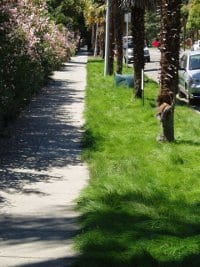by Josh Fodor
California has received a welcome reprieve from the drought with above average rain fall this winter. Although we may not be faced with stringent outdoor water use restrictions this summer, now is a great time to plan for future dry years, which are sure to come. Installing and establishing drought tolerant landscapes is easiest in good rain years, when plenty of summer irrigation water is available to get your new plantings established.
One of the best ways to reduce your summer water use (and your water bill!) is to replace water thirsty lawns and exotic gardens with California native grasses and flowering plants. There is a wide range of native plant landscapes styles to choose from. Whether your preference is a relaxed cottage garden or a more formal manicured landscape, there are good choices for even the most discriminating eye.
Drought Tolerant Lawns
Many people who decide to remove their conventional lawns want to replace them with a drought tolerant lawn of some type. There are more options than ever for using native grasses as alternatives to traditional turf. The main considerations are: 1) what type of native lawn is suited to your property, 2) what are your use requirements, and 3) what method of establishment is the most cost effective?
The first point is to determine what species of grass will perform the best and use the least water at you particular location. It is important to match the native grass species to soil type, drainage and sun exposure. For example, Western fescue (Festuca occidentalis) is a good choice for planting in shaded areas, whereas June grass (Koelaria micrantha) is best for harsh, shallow soil and full sun.
The next point to consider is the intended use of the new lawn area. If the lawn area will be strictly ornamental, red fescue (Festuca rubra) or a grass relative such as foothill sedge (Carex tumulicola) are good choices. Perhaps the lawn will be used for a dining area or for a children’s play area, then bent grass (Agrostis pallens ) or purple needle grass (Nassella pulchra) will do well. Currently the only limitation is for intensive play areas, as none of the commonly available native grasses are suitable for heavy traffic.
The final consideration is which method to use for establishing a native lawn. The main options, in order of most to least expensive, are: 1) native sod, 2) plug plants, or 3) seeding. Although native sod is more expensive than traditional sod, it is rapidly gaining favor as the preferred method because as with traditional sod, you roll it out and it is done. Plug planting is a good option for larger ornamental areas, especially if multiple species are to be used. Broadcast seeding, of one or many species, is an economical choice for very large areas, but the trade off is often seen in the amount of effort required to get it established. The cost of weed management alone can far out weigh the installation cost savings of seed versus native sod.
Lawn Alternatives
Another lawn substitute option is a native habitat garden. Habitat gardens are designed to mimic nearby natural plant communities, such as meadows, shrub lands or oak woodlands. The most adaptable plant community for a small garden is the native meadow. On the central coast, most of the grasses found in meadows are perennial bunchgrasses. Native bunchgrasses are very drought tolerant and remain green throughout the summer with little or no water. Bunchgrasses provide a diverse array of form, texture and color. Interspersed with native wildflowers, the meadow garden will provide year round beauty as well has habitat for birds and butterflies.
Many excellent books on California native plants and grasses for the garden have recently been released; two in particular are noteworthy. The American Meadow Garden: Creating a Natural Alternative to the Traditional Lawn by John Greenley (Timber Press, 2009), and “Reimagining the California Lawn: Water-conserving Plants, Practices, and Designs”, by C. Bornstein et al. (Cachuma Press, 2011). The possibilities are endless; let your imagination go wild this spring!
About the Author
 Josh Fodor is the owner of Ecological Concerns Inc. (ECI) and Central Coast Wilds (CCW) nursery in Santa Cruz ECI is a landscape firm specializing in ecological landscaping and habitat restoration, and CCW is a California native plant nursery. Josh can be found at www.centralcoastwilds.com or jtfodor@ecologicalconcerns.com.
Josh Fodor is the owner of Ecological Concerns Inc. (ECI) and Central Coast Wilds (CCW) nursery in Santa Cruz ECI is a landscape firm specializing in ecological landscaping and habitat restoration, and CCW is a California native plant nursery. Josh can be found at www.centralcoastwilds.com or jtfodor@ecologicalconcerns.com.




